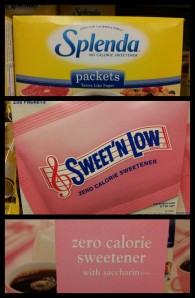Posts Tagged nutrition
Artificial Sweeteners – Sucralose (Splenda)
Posted by Jesse Thornton in Nutrition and Health on August 11, 2014
 Artificial sweeteners are sugar substitutes that provide no nutritional value and are made by chemical processes, rather than naturally occurring in the environment. As such, there’s always a lot of negative attention directed toward artificial sweeteners and indeed, anything labeled as “artificial.” I’ve decided to do a series of articles on artificial sweeteners to find out what claims are true and what isn’t, instead of doing one article with a bullet point list. There’s just too much information to condense everything into one article and I like to include as much context as possible because most things are not black and white issues, and this topic is no exception. So the first article in this series will concentrate on what science currently has to say about the most widely used artificial sweetener on the market: sucralose.
Artificial sweeteners are sugar substitutes that provide no nutritional value and are made by chemical processes, rather than naturally occurring in the environment. As such, there’s always a lot of negative attention directed toward artificial sweeteners and indeed, anything labeled as “artificial.” I’ve decided to do a series of articles on artificial sweeteners to find out what claims are true and what isn’t, instead of doing one article with a bullet point list. There’s just too much information to condense everything into one article and I like to include as much context as possible because most things are not black and white issues, and this topic is no exception. So the first article in this series will concentrate on what science currently has to say about the most widely used artificial sweetener on the market: sucralose.
Sucralose (Splenda)
Surcalose, best known as the key ingredient in Splenda, is a non-nutritive sweetener 600 times sweeter than sugar by weight. The molecule itself is produced by a series of chemical reactions, starting with sugar as a base, then, stripping away 3 hydroxyl groups from the original sugar molecule and replacing them with chlorine atoms. The added chlorine atoms make sucralose sweeter than sugar while also preventing it from being metabolized by the body. This means that sucralose is not used as an energy source by the body and is simply eliminated as a waste product. Read the rest of this entry »
Hype and Potential Behind the Therapeutic Promises of Curcumin: From Alzheimer’s to Cystic Fibrosis
Posted by Jesse Thornton in Nutrition and Health on July 3, 2014
Turmeric is a root belonging to the ginger family, and like ginger, is used prominently in oriental cuisines. Owing its yellow color to a compound called curcumin, the root is probably best known as the spice used in curries. Like its ginger cousin, turmeric has been used for medicinal purposes for thousands of years. I’m not entirely sure how we know the timeline or how much truth is in that statement. Nonetheless, I will parrot that as truth since we as humans often have this immutable faith in the supposed medicinal value of things we pull out of the ground. As it turns out, there does appear to be some real potential medical applications, not with turmeric itself, but with curcumin. Some of the claims are hype, some of them show a lot of promise with a little more research, and there may actually be some benefit in taking curcumin now.

